Dark Matter Sentry Streaming Microphone – The Blue Yeti Killer?
USB microphones were once the purview of the podcaster and gamer. No longer. With so many people working and living online, having a good-quality microphone is a must. The budget mic choice for years has been one of the Blue Yeti offerings. Monoprice is looking to break into that market with the introduction of the Dark Matter Sentry Streaming Microphone. At $129.99 retail, the Blue Yeti is a reasonable purchase. At $99.99 MSRP (and currently $69.99) the Dark Matter Sentry is a steal. But how does it perform? Let’s take a closer look!
Dark Matter Sentry Streaming Microphone Specs
| Microphone Type | Back electret condenser |
| Pickup/Polar Patterns | Cardioid, Bidirectional, Stereo, Omnidirectional |
| Audio Connection | USB 1.0 or 2.0 |
| Frequency Response | 20Hz ~ 20kHz |
| Sensitivity | ‑36dB ±2dB (0dB=1V/Pa at 1kHz) |
| Maximum SPL | 130dB |
| Microphone Gain | ‑12dB, 12dB maximum |
| Output Impedance | 32 ohms |
| Sampling Rate | Up to 96kHz |
| Bit Depth | 24‑bit |
| LED Accent Lighting Colors | Pink, yellow, white, blue, green, off (no lighting) |
| Compatible Operating Systems | Windows XP/Vista/7/8/10, macOS 10.x or later, Linux |
Sentry Streaming Mic Setup
The Sentry Streaming Mic is fairly easy to set up. It comes with a number of accessories. There is an included “spider mount,” a fabric-sheathed USB cable, and a stand screw. The screw attaches the mount to the mic. There is a hole in the mount that allows the USB cable through as well as access to the bottom button. The button controls the color of the lights. For those that want a less flashy microphone, the lights can be turned off.






The USB-C connection on the bottom of the microphone makes connecting the cable easy, even through the small window in the mount. I connected the Dark Matter Sentry Microphone to my laptop and it was quickly recognized. I didn’t need to update anything or download any software. It just worked. I used it with Audacity as well as Reaper with no problems. This was truly a plug-and-play experience.
Dark Matter Sentry Controls
There is something to be said for having all the controls on the front of the microphone. There are dials for input gain and headphone volume as well as a 3.5mm headphone port. The gain knob can be depressed to mute the mic. This changes the color of the lights to red. The input gain is particularly nice as it allowed me to address any clipping issues in real time. My suggestion is to connect the mic and create a test recording. Put the mic where you think it will live and start to talk. Make sure to test every possible volume from loud exclamations to whispers.

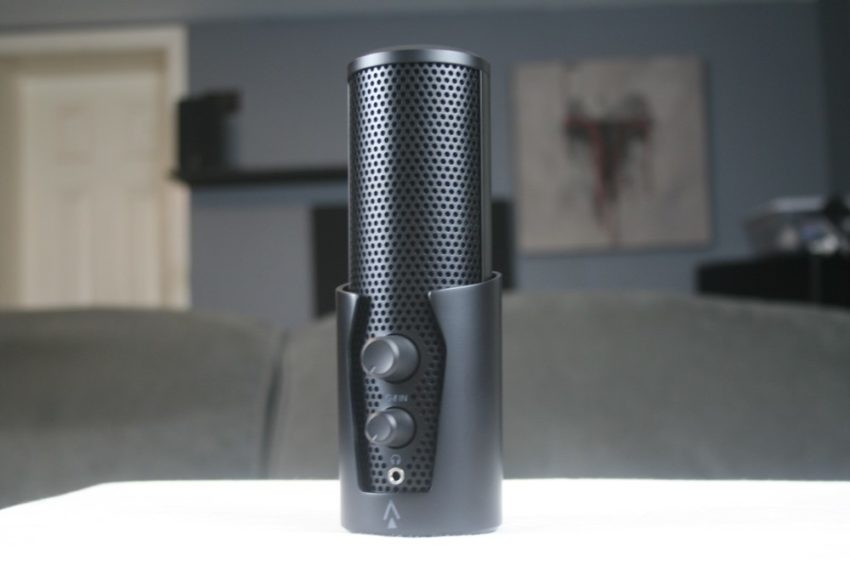

The top of the Dark Matter Sentry Microphone has a “Mode” button. This allows you to switch between the mic modes. Available are Cardioid, Bidirectional, Stereo, and Omnidirectional. Bidirectional and Stereo are essentially the same as they primarily record from two opposing sides. The Cardioid focuses on directly in front of the controls while Omnidirectional accepts sounds from all directions. The Dark Matter Sentry is a side-address mic. The lights on top conveniently let you know your mode as well as where the mic will accept sounds. No guessing where to talk into the mic!




Dark Matter Sentry Sound Quality
I’ve been podcasting for a long time and I’ve used the Audio Technica AT-2020 mic the entire time. It is currently connected to PreSonus AudioBox 44VSL. While the AT-2020 costs only a little more than the Dark Matter Sentry, it is just a microphone. It requires an external USB pre-amp like the PreSonus. That adds seriously to the cost. To examine the differences between the two and the different recording modes, I made a short audio.
As you can hear, the Audio Technica is definitely a warmer microphone with more bass. That said, after a second or two of the Dark Matter Sentry, those differences all but disappear. The Sentry is a great-sounding mic at a fraction of the price.
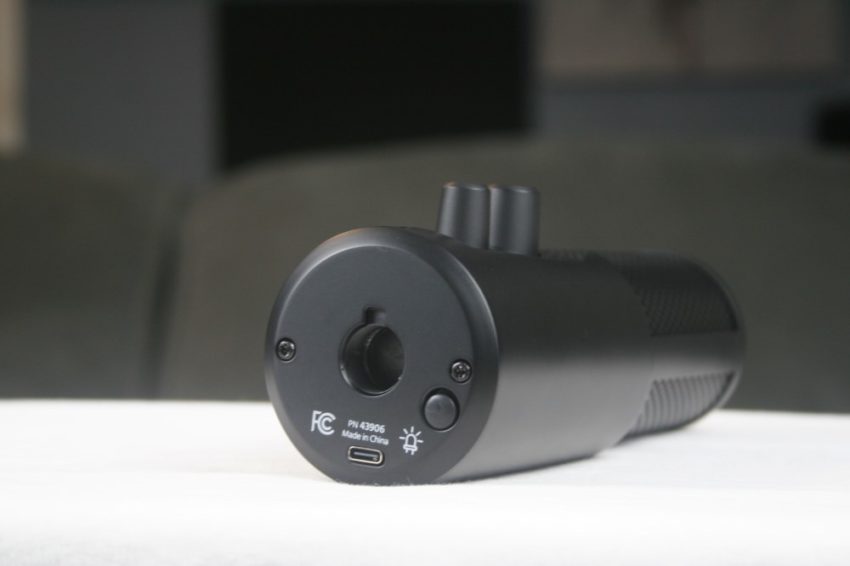


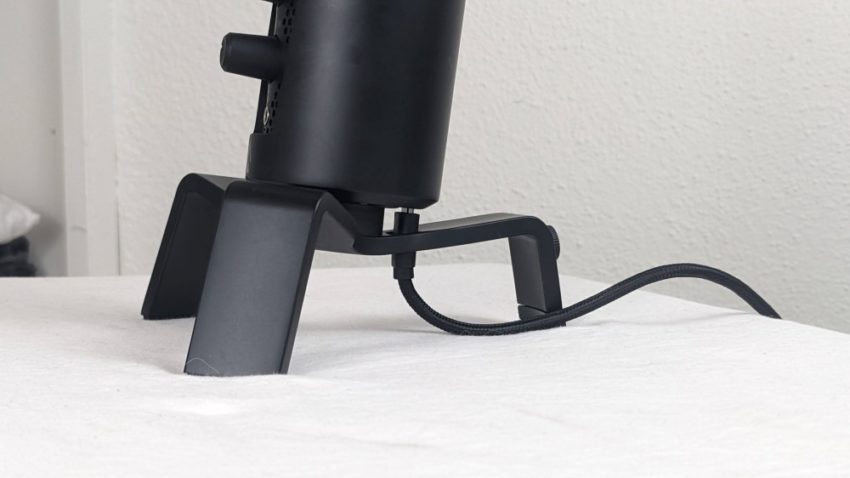

One thing you’ll notice is that the different modes don’t really sound all that different. I spoke into the front of the mic for every test. While the different modes might favor different orientations, it doesn’t mean that no sound from the other directions will be recorded. It may favor sounds from certain directions, but it doesn’t ignore the other sounds. The key is that you’ll want to address the room acoustics in your recording environment to minimize reflections and echoes. No mic is going to be able to make a bad environment sound good.
External Noise – Mount
The Sentry might be a great mic, but I’m not a fan of the stand. Mostly, it is because they called it a spider mount. When I think of spider mount, I think more along the lines of a shock mount. This is not that. The mount is slightly adjustable with its back leg. But it has no way to dampen any vibrations that might enter the recording from touching or bumping the table. In fact, while there are small rubber feet on the bottom of the legs, they seem to do nothing to decouple the microphone. You’ll want to invest in a shock mount if you want to use the Dark Matter Sentry Microphone for recording (or if you don’t want to annoy other people on your conference calls). A quick search of Amazon revealed a number of affordable options out there.
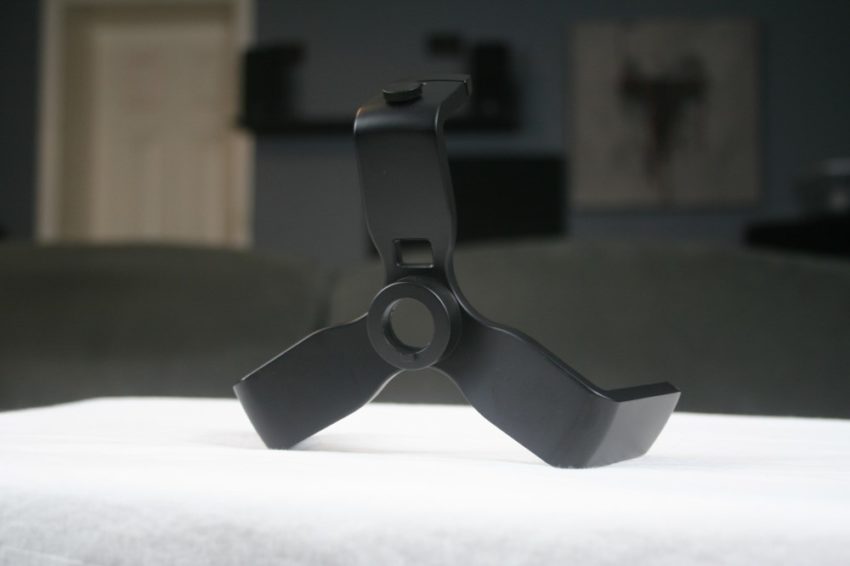

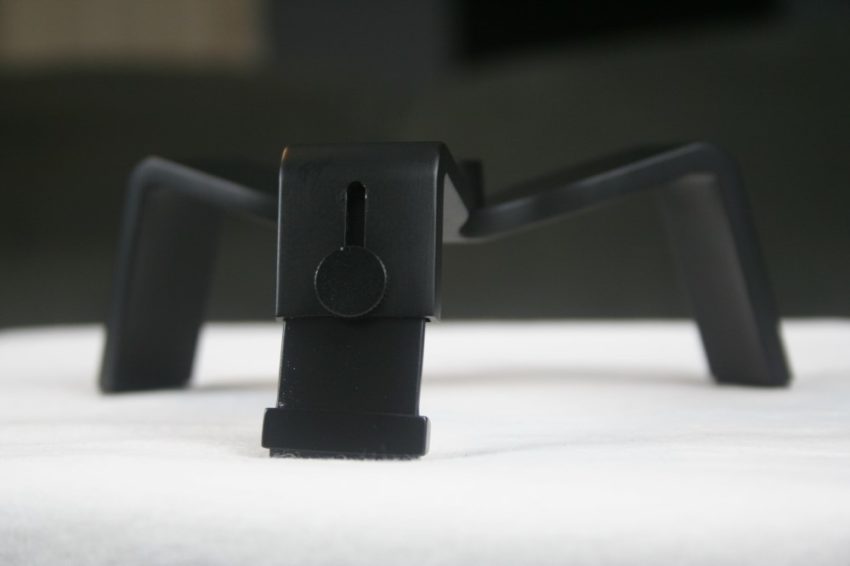
External Noise – Buttons
I was worried about vibrations traveling into the Senty mic. The knobs turned silently which was a nice surprise. Fabric cables (like the USB cable provided) often do transmit noise. While I could hear a little noise if the cable was moved, as long as it wasn’t physically hitting the table, It was almost inaudible.
Unfortunately, the mute and light color buttons were clearly audible. The click from muting the mic was audible both when engaging and disengaging the mute function. Lastly, I noticed that the Sentry didn’t always remember my last mode preference. It sometimes defaulted to Bidirectional. With the lights on the top, this was easily noticeable and corrected.
If you run the mic with the lights off, it will not show you the mic mode when you power it on. You’ll have to click the bottom button to show the mic pattern. It seems like it should at least flash the lights when powering on by default. But it doesn’t.
Wrap Up
If you are looking for an inexpensive USB microphone, the Dark Matter Sentry is clearly a winner. It has more features than you’ll probably use, it is a breeze to set up, and it creates fantastic recordings right out of the box. At $70, this mic is an absolute steal. I honestly can’t believe how good it sounds. If you want to start podcasting, or you just want to sound better on your group calls, the Dark Matter Sentry microphone is a must-buy.


